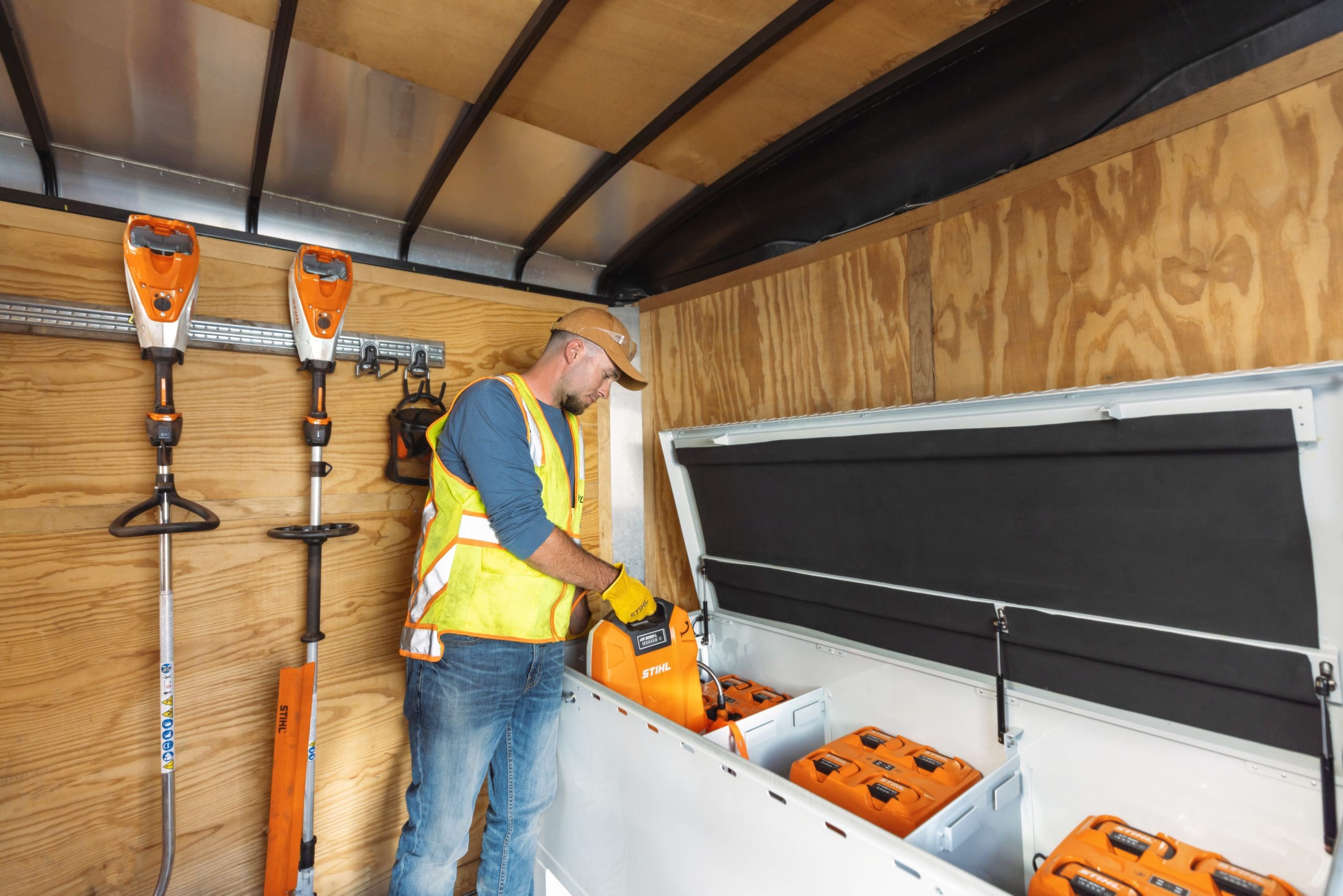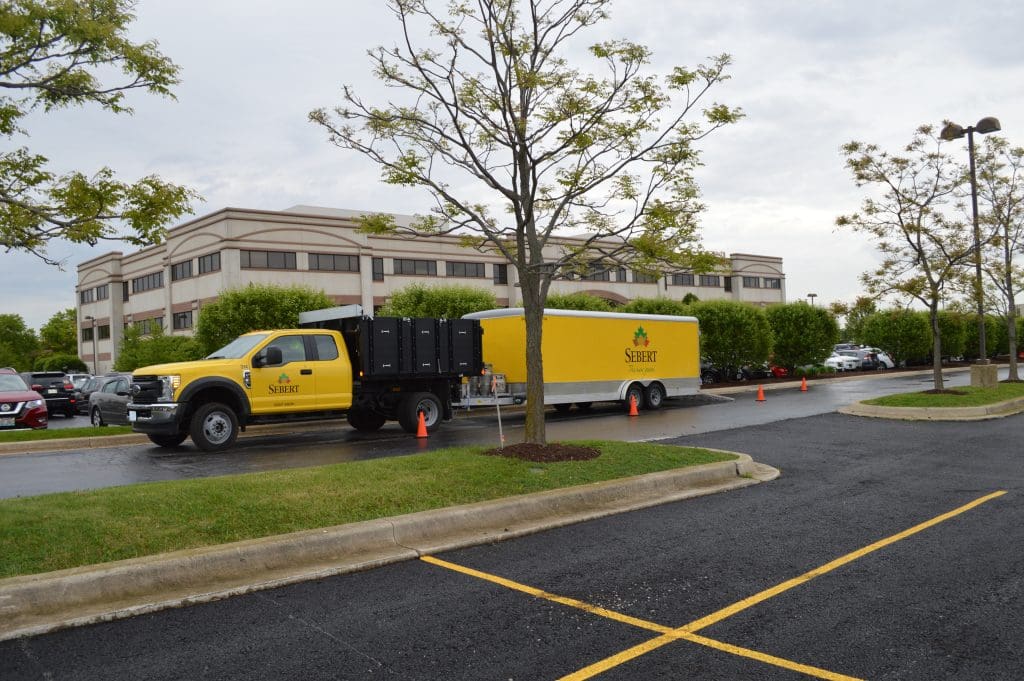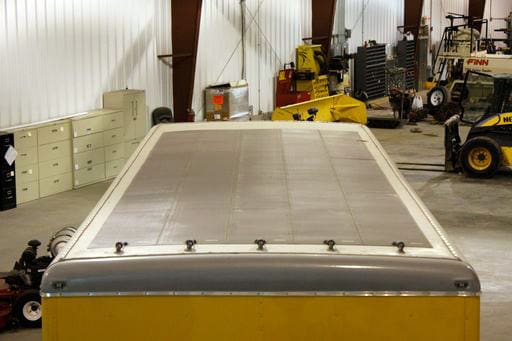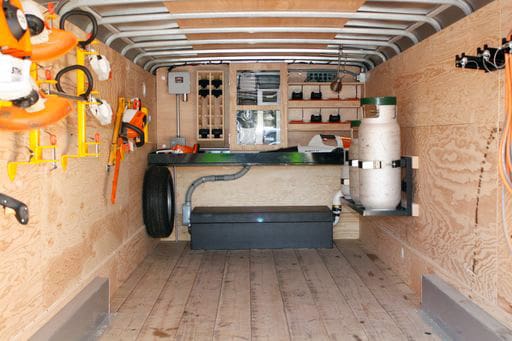
Is your trailer ready for battery-powered equipment? It might seem like a cut-and-dried process to swap out your gas cans for battery packs, but reconfiguring your trailers requires careful thought and consideration to be set up for success.
Research Is Key
The first consideration is determining how many pieces of battery-powered equipment and batteries each trailer will need to carry. Armando Vega, CEO and president of Enviro Views, based in Richmond, California, says you need to do your homework to know what tools you need to get the job done and what brand will give you the necessary range.
“Talk to your local dealers who have vetted these companies, so you’re not the guinea pig,” Vega says. “The dealers have the information from the manufacturers. They can tell you, ‘Okay, this one has been vetted, has been tested and proven to allow your professionals to do your work with this type of tool.’”
Bob Deasy, maintenance division manager for Blue Claw Associates, Inc., based in Osterville, Massachusetts, says that one of the biggest expenses is outfitting the crew with enough batteries so they can work a full day.

Once you know how many pieces of equipment and batteries you plan on transporting, then you can consider how much space is needed to accommodate them. Dan Mabe, CEO and president of American Green Zone Alliance, suggests using a carrying or storage case for batteries to provide safe transport, security from theft, and help protect the batteries and chargers in inclement weather.
He also advises mounting as many tools as possible to save space and provide easy access. He says it also serves as a form of preventive maintenance.
“AGZA has collected data for over a decade that clearly shows tools that are taken care of, mounted, and stored properly during transport can last eight to ten years,” Mabe says. “Of course, the quality of the brand factors into this as well as workforce habits and behavior.”
Vega says he mounted his equipment so there is no vibration and the equipment is organized so his crews can be very systematic and productive.
“I figured the electrical equipment is three times more (expensive) than gas power; we better take care of it,” Vega says.
Open Versus Enclosed Trailers
You may think a battery-powered fleet will require you to use enclosed trailers, but Mabe says open-air trailers can be used for battery crews. The three main considerations for this route are transportation, security and inclement weather.
The DOT has rules for transporting lithium batteries and other local laws may be in place as well.
“Make sure all of your batteries are securely fastened and stored in an organized, uniform way,” Mabe says. “Batteries should not be piled on top of each other, stored in places where they can contact metal materials, directly in the sun, and exposed to rain.”
Like anything else on an open-air trailer, batteries and battery-powered equipment run the risk of theft. Batteries not in use should be stored in ventilated lock boxes. Battery equipment in open-air trailers are also exposed to direct sunlight, rain, various moisture levels, and dust more than enclosed tools. Mabe advises reviewing battery equipment manufacturers’ IP rating claims.

“IP ratings will give you information on solid foreign objects and protection from moisture and water,” Mabe says. “IP ratings of battery electric tool platforms are especially important to research and understand prior to purchasing tools and operating an electric business route with an open-air trailer.”
Because of these issues, Blue Claw and Sebert Landscape, based in Bartlett, Illinois, opted to use enclosed trailers for their battery-powered fleets.
Vega decided to create a patent-pending hybrid trailer that is half-enclosed and half-open air. While his battery-powered mowers are exposed, everything else is stored inside the enclosed portion of the trailer.
Overnight Versus On-The-Go Charging
Selecting enclosed trailers opens up the possibility of overnight or on-the-go charging. Vega prefers to only do overnight charging where the batteries charge on the trailer at his facility. He found this to be more productive than having crews unload all the batteries at the end of the day. He says it saves them probably 20 minutes a day.
He says he sends his crews out with six batteries per trailer and this is enough to get them through the day. Vega says he did look at adding solar panels to his eight trailers.

“I thought about it,” Vega says. “I did some research and it was costing at that time around $10,000 per trailer to install solar panels and, for us, the return on investment was not there.”
Because they only charge at their facility, Vega says they had to make sure they had the infrastructure to support charging all the trailers simultaneously without tripping the breaker. They upgraded their control panel so each trailer has its own circuit breaker.
“When you’re charging all these batteries at the same time, it adds up,” Vega says. “We learned 20 amps per trailer and you don’t have the problem of tripping the breaker.”
Dan Bitler, fleet manager for Sebert, says the size of your fleet should be a serious consideration.
“This will play a major role in the infrastructure needed to supply the necessary power to multiple batteries being charged simultaneously,” Bitler says. “One or two crews may be easily handled with little or minor mods to infrastructure. As the fleet size increases, so does the need to make changes to your infrastructure.”
If you decide to charge your batteries throughout the day, Bitler says you need to determine how you want to approach that, whether it’s solar, a gas-powered generator or a large battery bank. Sebert utilizes both solar panel trailers and plug-in trailers. Steve Pearce, vice president of operations for Sebert, says their solar panels charge a battery bank that is then used to charge the tool batteries.
Bitler says it’s moderately challenging to outfit an enclosed trailer with solar panels. They do theirs in-house and it takes them about one day. Deasy says they currently have one trailer with solar panels that they bought from Super Lawn Trucks.

Photo: Sebert Landscape
“We can run eight chargers at one time using solar to get all of our 30amp batteries charged,” Deasy says.
Deciding to add solar panels is an operational and financial commitment. Mabe says that the total amount of battery capacity and amperage drawn from the chargers will determine how extensive and expensive a solar design will be.
“Solar charging is not just solar panels,” Mabe says. “The investment is in the panels, backup battery, inverter, wiring, and other system monitoring components. The system will need upkeep as with any other system or equipment. Once companies determine a solar design can work, the costs need to be understood to ensure there is a clear pathway to a return on investment. Some will consider solar designs for personal reasons or to enhance the marketability of a company’s commitment to reducing fossil fuels in their overall operations.”
Mabe says opting to use generators to charge batteries in the field defeats the purpose of battery electric equipment.
“Battery capacities and tool efficiencies have evolved enough to negate the need to use a gas generator for charging needs,” Mabe says. “We are now starting to observe some electric generators with battery storage and inverters used for supplemental charging in the field. People need to do their math and figure out if it is more cost-effective to purchase another battery or two than invest in mobile gas or electric generators.”
Battery Storage and Safety
When adding charging docks to enclosed trailers, ensure there is proper ventilation and temperature control. Mabe advises understanding your total amperage draws with various chargers and hiring a licensed electrician to install circuits, breakers, and wiring. Do not use power strips to plug in multiple chargers. Instead, use power managers like the TOWA PDM.
Proper battery storage is necessary to prevent overheating. Try not to store and charge batteries in direct sunlight for extended periods of time. Be sure to carefully read the operating manuals to understand the recommended temperature thresholds where batteries are charged and stored.

Mabe says while they have not observed or experienced any melting of plastics, components, or lithium battery cells to date, AGZA does have data demonstrating excessive and constant exposure to higher temperatures will decrease the overall “Cradle To Grave” cycle life potential of batteries.
Vega says he was concerned about heat affecting his batteries at first, but then he realized their battery compartment was cool enough the batteries are safe. Bitler and Deasy note that while warmer weather hasn’t been an issue for them, they do have to store batteries indoors to prevent damage from freezing temperatures.
If you decide to go the open-air trailer route, do not store your batteries in the truck cab in an attempt to keep them more secure.
“Truck cabs are very small, enclosed places with little to no ventilation unless in transport with the windows open,” Mabe says. “The upholstery and other materials are much more flammable than the materials of the back of a trailer or truck bed. This can cause an unventilated hot environment even in moderate temperatures. For these reasons, it is not recommended to store or charge batteries inside the cab of a truck.”
Advice for Others
Mabe says it is best to take your time transitioning your trailers for battery-powered operations.
“Take time to explore ‘peer to peer’ information gathering and conduct several number crunching exercises on the associated costs of battery electric versus gas operations,” he says. “Weigh the benefits which are many, versus potential pitfalls, which can be financially catastrophic. Look for any tax credit or cost reduction programs available to you to lower the startup costs.”
Deasy cautions that outfitting trailers for battery operations is an expensive venture. They have around 15 to 20 batteries on each trailer.

“You should really have solar panels, a bank of batteries to store the power absorbed by the sun and more batteries and chargers than you think you should have,” Deasy says.
AGZA recommends purchasing enough batteries to use and swap out during the day to meet your workload needs. Buying this many batteries is costly upfront, but Mabe says it ensures you have extra power and eliminates range and usage anxiety.
“Make it easy for the crews to use and understand the charging times and charging needs,” Pearce says. “It is a new way of operating crews. Training and buy-in are key to the success of the transition to battery.”
Vega says one of the biggest keys to their success has been retraining his crews on how to use battery equipment.
“With gas-powered equipment, you run out of gas, you pour in some more,” Vega says. “So with us, we’re like, okay, we bought enough batteries, but if you go full throttle, you’re going to run out of juice quickly.”
He says when they first started using battery equipment, they’d run out of power all the time until they learned they could use medium or low settings and go all day on one charge.
“It’s just managing how to use your tools and you’re still being productive,” Vega says. “The string trimmer was still doing its job; the hedge trimmer was still doing its job. It’s just that we’re so accustomed to gas power that we just go full-throttle everything all day long.”
This article was published in the July/August issue of the magazine. To read more stories from The Edge magazine, click

